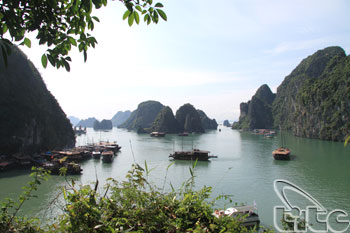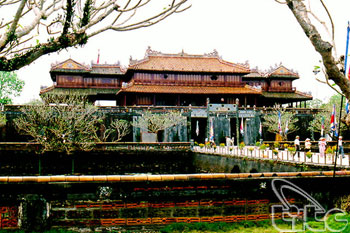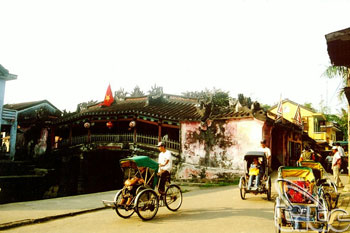My first time in Vietnam, and driving in from Hanoi Airport in the gloom of pre-daylight I felt elated, almost like being 20 again and staying out till dawn.
 |
|
Ha Long Bay are among Vietnam's main attractions
|
I was still sleepy, though, with half the night lost to the time-change, and glad enough to crawl under a crisp, white king-size duvet for an hour or so at the Movenpick Hotel - which offered calm luxury and a great, late breakfast - before sallying out to explore.
With six million people and three million motorbikes, Hanoi certainly hums. Girls ride the bikes, their long hair flying out from helmets, and couples pin toddlers between them. It's a thrilling, throbbing, moped-dodging city - and a challenge to life and limb.
I saw noodle-cooking on pavements, squatting flower sellers, unfamiliar foods and, when I could drag my eyes away from the pulsing pavements, right above the tight-packed little stores were glimpses of the dilapidated, centuries-old French colonial architecture.
Flagging a bit by evening and, with an early start next day to the Red River Delta and Ha Long Bay, my husband Michael and I ate in the hotel. It was a gourmet experience without the fuss - steamed sea bass and a light spicy Vietnamese chicken curry were both delectably good.
On the way to Ha Long Bay, the rice fields were stubbly, waiting for the weather to warm them, but it was a new and appealing landscape. We stopped at a shopping complex for coffee where the beautiful, lacquered papier-mache dishes and boxes on sale were irresistible.
And Ha Long Bay, when we arrived, was a dramatic sight. Extraordinary rock formations sprout out of the water and you can make out strange shapes: a lion's head, a dragon, a cup with a handle.
Our Hanoi guide, Mr Binh, had arranged a boat trip and we chugged out among the rocks, passing a floating fishing village before mooring at a tiny hilly island to see a cave. It was a bit damp and chilly, and as we climbed some steep steps, I have to admit that my heart wasn't entirely in the expedition.
But then we were suddenly in a cavern the size of a stadium. The cave was elegantly lit, with stalactites meeting stalagmites, and it was spell-binding. Mr Binh told us that the cave was only discovered in 1910, by a farmer climbing the hill to cut wood.
He fell 90ft through a hole, but somehow lived to tell the tale.
'Where can we eat tonight that's cheap, fun and local?' I asked Mr Binh.
He smiled. 'Quan An Ngon in Phan Boi Chau Street. It's a short walk from your hotel. Good local food and a very few dollars.'
What we found there was a buzzing emporium of an eatery, outdoors under huge sail-like canvasses and packed with talkative families and upwardly mobile young locals.
We loved the whole new experience. Michael's 'seafood hotpot' arrived as a plate of uncooked fish, shellfish and veg, and a cauldron of hot water set to boil on a burner.
He looked at it all in complete panic. A group of giggling waitresses soon gathered, bursting to practise their English and show him the ropes. 'I see you on television,' one said, which seemed highly unlikely. But we weren't complaining; both the fish' once cooked - and the bill were a treat.
We flew south towards our final destination, Ho Chi Minh City, stopping first for a fleeting visit to Hue, Vietnam's ancient capital, now a world heritage site, where we hit a rainy day.
 |
|
Hue citadel
|
This was a pity as it was our only chance to see the Citadel and stay in the famously elegant La Residence Hotel on the banks of the Perfume River. Heads down and encouraged by our effervescent new guide, Mr Thong - whose English, learned from the BBC and Voice of America, had a powerful American GI's twang - we squelched round the vast walled site of the Citadel.
Seat of the Nguyen emperors of the 17th and 18th Centuries, and with its own Forbidden City in which the emperor, queen and a multitude of concubines used to reside, it was sadly war torn.
'My kids don't think about the war,' Mr Thong said, pointing out shrapnel scars and a shattering bullet hole in a magnificent mirror. 'It's the past.'
Not for him, we felt. Hue had suffered some of the most aggressive bombing of the war. The Citadel had survived, stripped of many treasures yet still remarkable and memorable.
With only one night in Hue, we checked out TripAdvisor for somewhere interesting to eat, and a small cafe called Bloom that was associated with a charity for homeless children won our vote.
The set menu seemed a brave choice at first, but it was great. We were served with an array of small dishes, flavourful soup, slivers of vegetables and beef and a piquant mango salad. The girl serving us was delightful and once again the bill was incredibly small.
La Residence Hotel, colonial home of past French governors, seemed a splendidly appropriate place to stay, with its fine period style and dramatic setting on the Perfume River.
It gained its name from a legend about scented grasses that once lined its banks and which permeated the whole town with their aroma.
Off promptly in the morning to Hoi An, we took the main highway. The road wound over the Cloudy Mountain range that was true to its name, passing lush paddy fields and fish ponds on the way to the city of Da Nang. Beyond were pure white sandy beaches - that saw the first landings of American troops - and stretched down the coast for 20 miles.
It was a gorgeous foretaste of what was in store at our resort hotel, The Nam Hai, where we planned three wonderful days of beach walks and relaxation. The Nam Hai's accommodation was resplendent: individual villas had indoor and outdoor showers, lavish Jacuzzis and lounger beds.
A magnificent, unending beach was right outside our door. And the food: would we choose Asian or Western, would we eat poolside? Such decisions...
I fell in love with the little town of Hoi An at first sight. Small shops sold very cheap silks while sophisticated boutiques, cafes and lively restaurants lined the river bank, whose bridge at nightfall was lit by glowing lanterns.
 |
|
Hoi An Ancient Town
|
It was with-it, stylish and original, Vietnam's answer to St Tropez - but without the topless girls. We ate at Miss Ly's Restaurant on the recommendation of the manager at La Residence who knew Miss Ly's American husband, Nathan. The food was perfect and, again, amazingly cheap.
Inspired, I signed up for one of the cooking classes offered by The Nam Hai. First, we shopped in the market (a photographer's dream), bought banana flower - shredded by a stallholder with a fearsome knife - uncooked shrimp and yellow rice noodles. We picked herbs in the hotel gardens then cooked it all up to create an authentic Vietnamese dish.
The Nam Hai spa was a final indulgence. We had a kind of marital massage, both being firmly, yet relaxingly pummelled on beds side by side in a lakeside space. Life felt as good as it could get.
We continued south by air to Ho Chi Minh City, where it was hot, hot, hot. It was muggy too, but I never mind that; it's sexy weather to me.
We were booked into the Park Hyatt as part of our package. Outside was a high-rise madhouse. More people live in Ho Chi Minh City than Greater London, yet here, in the Park Hyatt's tropical gardens, sound-proofed by the surrounding hotel buildings, was a stunning pool.
We lounged in basket armchairs, sunbathing, swimming and luxuriously unwinding from the flight. It was Sunday and too late for much sightseeing so we explored the nearby streets, dodging a couple of chickens incongruously clucking around on the city pavements, before an early night in advance of an action-packed last day.
We spent our final day on a river boat in the Mekong Delta, the rice bowl of Vietnam, lunching in an ancient Mandarin house. The restaurant was family-run and had been their home for generations.
We made it back to the city just before the Independence Palace - now the Reunification Palace - closed. We toured it briefly, keen to see the room where the Vietnam War document of surrender was signed. The desk in it was bare, with no pen and no blotter, which was a little disappointing.
We left the palace a little more sober, but wondering at the irrepressible energies of all the young people up and down the land, moving on and busy building new lives.
Vietnam is knitted together, comfortable in its sort of entrepreneurial-communist skin, thriving, growing, a land of infinite variety and a joy to visit.
Sandra Howard